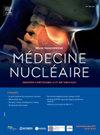基于体重指数的FDG PET-CT研究中脑摄取值的比较
IF 0.2
4区 医学
Q4 PATHOLOGY
Medecine Nucleaire-Imagerie Fonctionnelle et Metabolique
Pub Date : 2025-05-01
DOI:10.1016/j.mednuc.2025.01.187
引用次数: 0
摘要
目的在本研究中,我们旨在比较计算出的幕上和幕下区域的SUV值,并探讨BMI差异对脑葡萄糖摄取的影响,以评估超重和肥胖患者在接受全身FDG PET/CT研究时可能对大脑的影响。此外,我们的目的是评估可能的治疗效果幕上-幕下摄取值。方法本研究纳入736例患者,这些患者在过去6个月内接受了全身PET/CT成像,以诊断、分期、治疗反应、再分期和确定复发转移。通过幕上-幕下区域的SUVmax和suv平均值测量体重指数对超重和肥胖患者大脑可能产生的影响,并分析其与体重指数的相关性。结果BMI高组、幕上SUVmax、幕上SUVmean、幕下SUVmax、幕下SUVmean均显著高于对照组(P <;0.0001)。当根据影像学指征进行评估时,考虑诊断和非诊断指征(治疗反应、复发转移调查、重新分期),两组在平均年龄、性别和BMI方面无统计学差异。然而,在进行PET/CT用于诊断目的的组中,幕上SUVmax、幕上SUVmean、幕下SUVmax和幕下SUVmean在统计学上显著降低(P <;0.0001)。结论本研究结果显示,肥胖患者的幕上SUVmax、幕上SUVmean、幕下SUVmax和幕下SUVmean均高于其他人群。本文章由计算机程序翻译,如有差异,请以英文原文为准。
Comparison of brain uptake values in FDG PET-CT study based on body mass index values
Objective
In this study, we aimed to compare the calculated SUV values supratentorial and infratentorial areas, and to investigate the effects of BMI differences on brain glucose uptake, in order to evaluate the possible effects of this on the brain in overweight and obese patients who underwent whole body FDG PET/CT study. In addition, we aimed to evaluate the effect of possible treatment supra-infratentorial uptake values.
Method
This study included 736 patients who underwent whole-body PET/CT imaging in the last six months to diagnose, stage, respond to treatment, restage, and determine recurrent metastases. Possible effects of body mass index on the brain in overweight and obese patients were measured via SUVmax and SUVmean values of supratentorial-infratentorial regions and analysing their correlation with body mass index.
Results
The group of patients with high BMI, supratentorial SUVmax, supratentorial SUVmean, infratentorial SUVmax, and infratentorial SUVmean were significantly higher (P < 0.0001). When evaluated according to the imaging indication, considering diagnostic and non-diagnostic indications (response to treatment, recurrence-metastasis investigation, restaging), no statistically significant difference was achieved between the two groups regarding mean age, gender and BMI. However, in the group where PET/CT was performed for diagnostic purposes, supratentorial SUVmax, supratentorial SUVmean, infratentorial SUVmax, and infratentorial SUVmean were statistically significantly lower (P < 0.0001).
Conclusion
Regarding the outcomes of this research, supratentorial SUVmax, supratentorial SUVmean, infratentorial SUVmax, and infratentorial SUVmean were statistically significantly higher in obese patients compared to other individuals.
求助全文
通过发布文献求助,成功后即可免费获取论文全文。
去求助
来源期刊
CiteScore
0.30
自引率
0.00%
发文量
160
审稿时长
19.8 weeks
期刊介绍:
Le but de Médecine nucléaire - Imagerie fonctionnelle et métabolique est de fournir une plate-forme d''échange d''informations cliniques et scientifiques pour la communauté francophone de médecine nucléaire, et de constituer une expérience pédagogique de la rédaction médicale en conformité avec les normes internationales.

 求助内容:
求助内容: 应助结果提醒方式:
应助结果提醒方式:


